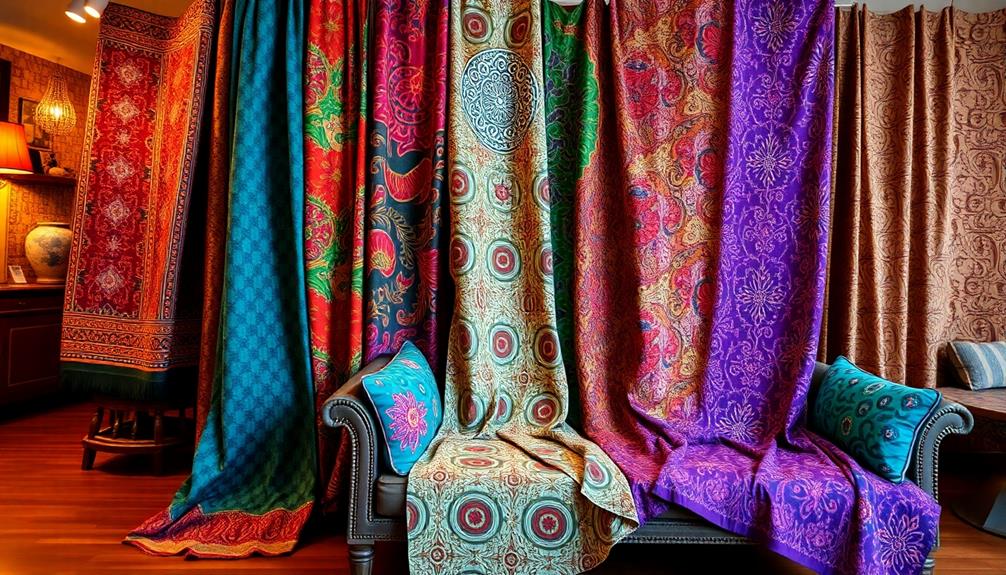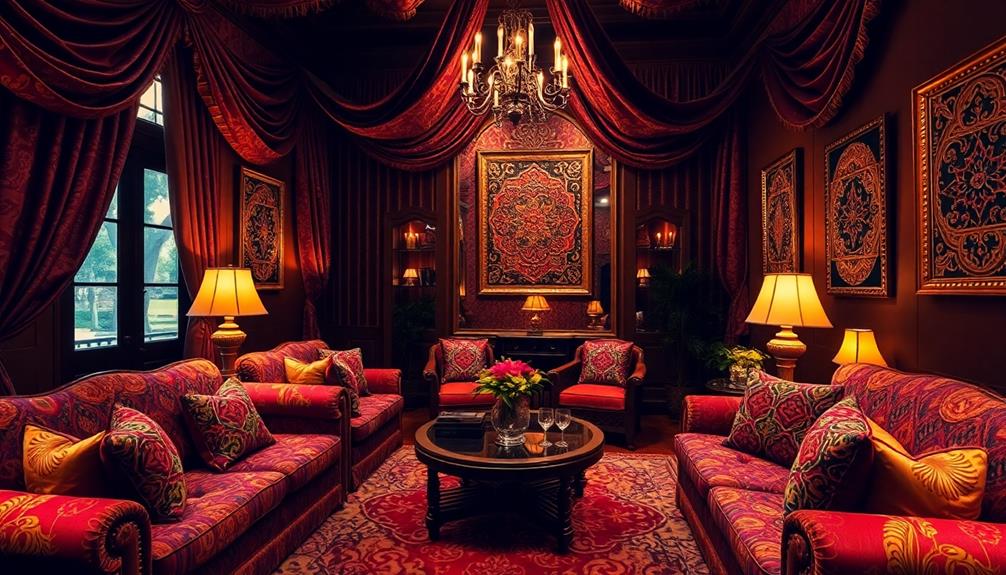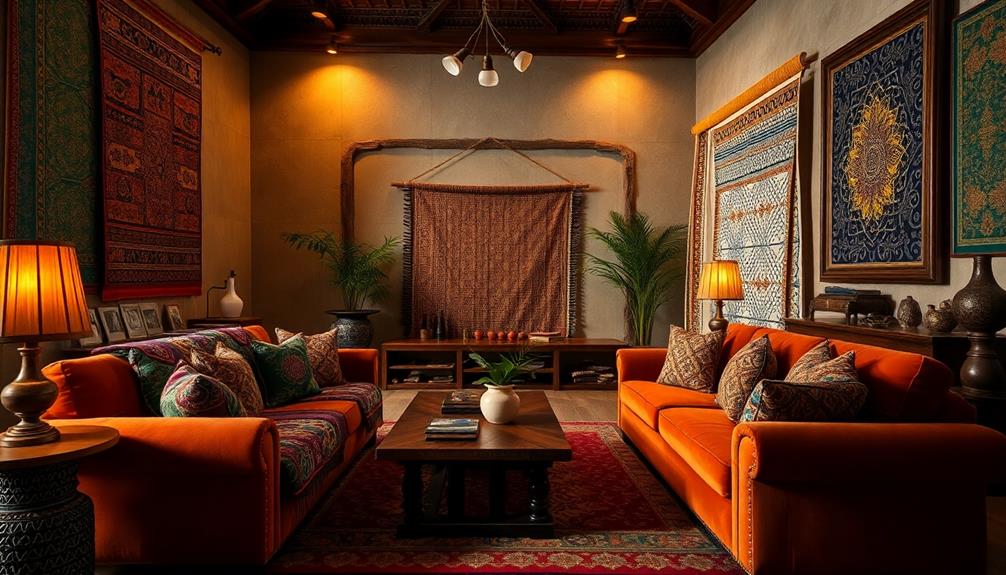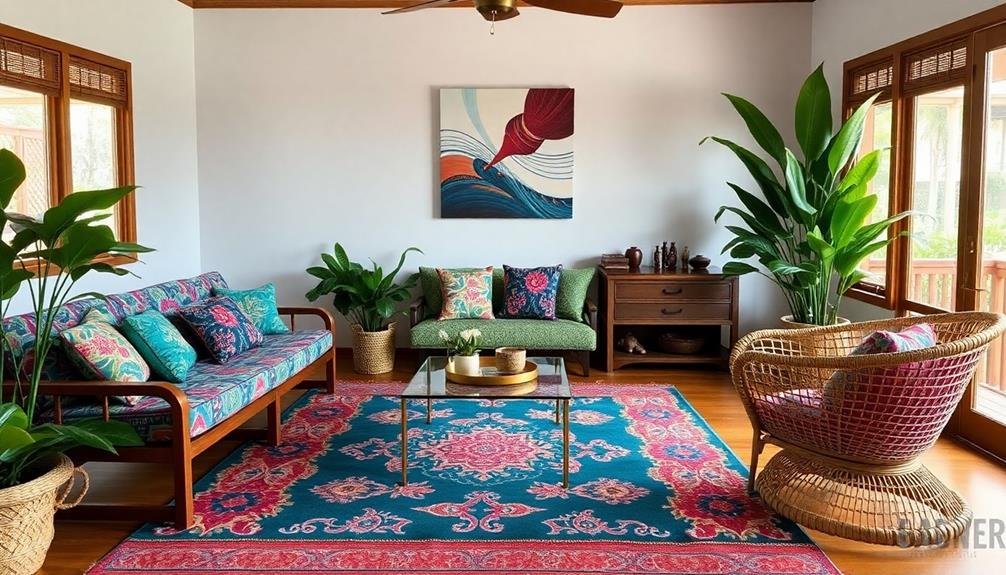Indonesian fabrics like batik and ikat can transform your space with their vibrant colors and intricate patterns. Batik uses a wax-resist dyeing technique to create stunning designs, while ikat features soft, blurred edges from its unique weaving process. Both fabrics reflect Indonesia's rich cultural heritage and craftsmanship, making them perfect for adding drama and luxury to any room. You can use these textiles in decorative pillows, upholstery, or statement pieces that catch the eye. Explore how these beautiful fabrics can elevate your decor and bring a touch of cultural elegance to your home.
Key Takeaways
- Batik's intricate patterns and vibrant colors create a dramatic focal point, enhancing the luxury of any interior space.
- Ikat's soft, blurred designs add depth and sophistication, making it perfect for upholstery and accent pieces.
- Incorporating luxurious textiles like songket introduces a rich, ceremonial feel, elevating the overall aesthetic of the room.
- Mixing Indonesian fabrics with materials like silk or velvet enhances texture, creating a visually striking and opulent atmosphere.
- Decorative pillows featuring traditional motifs not only enhance comfort but also celebrate Indonesian cultural heritage and craftsmanship.
Overview of Indonesian Fabrics

Indonesian fabrics are a vibrant tapestry of culture and craftsmanship, with batik and ikat standing out as two of the most celebrated forms. These textiles showcase intricate patterns and vibrant colors that reflect Indonesia's diverse cultural heritage, making them ideal for luxury interior design.
The use of Indonesian decorative pillows can further enhance the appeal of these fabrics, adding comfort and a personal touch to your space. Batik, particularly, employs a wax-resist dyeing technique that can be either hand-drawn (batik tulis) or stamped (batik cap). Each method exhibits unique craftsmanship and cultural significance, allowing you to choose pieces that resonate with your aesthetic. Incorporating batik fabrics into your home design not only brings vibrant colors and intricate patterns but also adds a cultural depth to your decor. If you’re looking for inspiration on **how to decorate with batik**, consider using batik textiles as wall hangings, table runners, or curtains to create a focal point that exudes warmth and heritage. Whether you choose understated modern designs or more traditional motifs, batik effortlessly enriches any interior with its timeless elegance.
Ikat, on the other hand, involves a labor-intensive process where threads are dyed before weaving. This technique results in soft, blurred designs that bring a timeless quality to your space. Both batik and ikat offer versatility, seamlessly integrating into various design styles while adding an exotic touch.
Additionally, textiles like patola and songket are known for their luxurious appeal, often featuring motifs that symbolize high status and cultural identity.
Unique Techniques and Craftsmanship

The artistry behind Indonesian textiles is truly remarkable, with each piece reflecting generations of skilled craftsmanship. Textiles made using traditional techniques like batik and ikat showcase unique design elements that elevate any space.
Batik involves a wax-resist dyeing method where artisans apply hot wax to fabric, creating intricate patterns that are dyed and reveal rich details. Each batik piece tells a story, preserving cultural heritage through traditional motifs. On the other hand, ikat features a complex weaving process that begins with tying and dyeing threads before weaving, resulting in soft, blurred edges and striking geometric patterns.
To give you a clearer understanding, here's a comparison of the two techniques:
| Technique | Characteristics |
|---|---|
| Batik | Wax-resist dyeing, intricate design elements |
| Ikat | Tying and dyeing threads, soft edges |
| Production | Labor-intensive, takes years for authenticity |
| Patterns | Traditional motifs, luxurious designs |
| Cultural | Reflects social status, deep heritage |
Cultural Significance and Heritage

Rich in cultural significance, Indonesian textiles like batik and ikat serve as vibrant expressions of identity and social status across various regions. Each piece you encounter carries intricate designs and traditional patterns that tell stories steeped in history.
Recognized by UNESCO as an essential part of cultural heritage, Indonesian batik showcases unique craftsmanship through its labor-intensive wax-resist dyeing techniques. These techniques vary by region, emphasizing the rich diversity within this textile art.
Additionally, traditional artistry in Indonesian decor, such as masks, complements the beauty of these fabrics, enhancing the overall aesthetic of any space.
The production of ikat, with origins tracing back over 5,000 years, highlights the global influence of Indonesian textile craftsmanship. As you explore these fabrics, you'll appreciate how they reflect virtues, nature, and local narratives, passed down through generations.
Both batik and ikat play significant roles in the local economy, supporting artisans and preserving traditional skills in contemporary markets.
Popular Fabric Types and Styles

Exploring the world of Indonesian textiles reveals a stunning array of popular fabric types and styles that can elevate any luxury space.
Batik, renowned for its intricate patterns created through a wax-resist dyeing technique, brings a cultural richness to your decor, much like the unique artistic expressions found in traditional Indonesian decor masks. You'll find options like hand-drawn batik, which showcases meticulous craftsmanship, making it a unique choice for bespoke projects.
Ikat, another enchanting fabric, features a resist-dyeing method where yarn is dyed before weaving, producing soft, blurred edges. This technique lends itself beautifully to patterned textiles that are perfect for upholstery and drapery.
For an even more opulent touch, consider songket, a luxurious textile woven with gold or silver threads, often used in ceremonial attire.
Patola textiles, with their vibrant colors and complex double ikat designs, are highly sought after for their dramatic visual appeal.
As an interior designer, incorporating these woven fabrics can transform your space into a sanctuary of elegance and style.
Whether you choose silk batik or any other luxurious option, the beauty of Indonesian textiles will surely enhance your home's atmosphere.
Incorporating Fabrics in Interior Design

When you incorporate Indonesian fabrics like batik and ikat into your interior design, you instantly create a vibrant, culturally rich atmosphere. These Indonesian textiles feature intricate batik patterns and rich colors, making them perfect for dramatic focal points in your living room or any other space.
Additionally, the cultural significance of these fabrics can enhance your decor by promoting appreciation for Indonesian artistry and craftsmanship, as seen with the importance of Indonesian decor masks. You can use them in various applications, such as curtains, cushions, and upholstery, enhancing both traditional and contemporary decor styles.
Consider using larger accent pieces, like statement chairs or wall coverings, to introduce a sense of luxury and sophistication. The unique craftsmanship of these textiles reflects regional heritage, adding an artistic narrative that resonates with cultural significance.
A design studio that specializes in Indonesian fabrics can help you select pieces that align with your vision.
To elevate the overall aesthetic, pair batik and ikat with sophisticated textures like silk or velvet. This combination not only adds depth but also showcases the highly valued artistry of Indonesian textiles.
Frequently Asked Questions
What Is the Famous Fabric Design of Indonesia?
The famous fabric designs of Indonesia include Batik, Ikat, and Songket. Each showcases unique dyeing techniques and cultural significance. When you explore these textiles, you'll discover a rich heritage woven into every piece.
What Is the Indonesian Textile Technique?
The Indonesian textile technique includes batik and ikat. You'll find batik uses wax-resist dyeing for detailed designs, while ikat involves dyeing yarn before weaving, creating stunning patterns. Both showcase remarkable craftsmanship and cultural significance.
What Are the Different Types of Fabrics in Indonesia?
Oh, you thought all Indonesian fabrics were just plain? Think again! There's Batik with its intricate designs, Ikat's soft patterns, luxurious Songket, traditional Tenun, and vibrant Plangi. Each tells a unique cultural story!
What Is Batik Made Of?
Batik's made from natural fabrics like cotton and silk, which absorb dye beautifully. Using a wax-resist technique, artisans apply hot wax before dyeing, creating intricate patterns that showcase vibrant, layered colors throughout the fabric.
Conclusion
Incorporating Indonesian fabrics into your space not only elevates your decor but also weaves a story of rich culture and artistry. By embracing these luxurious textiles, you're not just adding style; you're creating a vibrant atmosphere that speaks volumes. So, don't miss the boat—explore the unique patterns and craftsmanship that can transform your home into a sanctuary of elegance. With the right touch, you'll be living in a space that's as inviting as it is dramatic.










